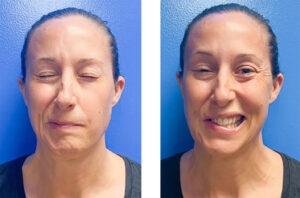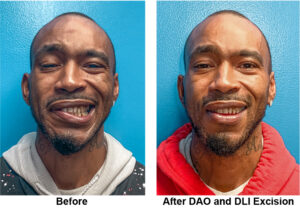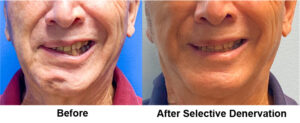Synkinesis
Facial synkinesis refers to involuntary and undesirable facial movements (aka “simultaneous movement”) associated with voluntary facial movements. An example is when one eye closes whenever a patient smiles. Synkinesis often develops in patients who have had Bell’s palsy. Synkinesis also frequently occurs in patients who have had Ramsay Hunt Syndrome, facial nerve repair, acoustic neuroma (aka vestibular schwannoma) surgery, and trauma. Synkinesis can occur anytime that the facial nerve is injured but still intact, or anytime the facial nerve has been repaired.
Why Does Synkinesis Occur?
The facial nerve regrows very well after injury as long as it has not been cut. However, as the nerve regrows the new branches do not always go to the proper facial muscles. Sometimes, what originally was one nerve branch becomes two branches going to different muscles in the face. These processes are collectively known as “aberrant facial nerve regeneration,” and can be thought of as miswiring of the facial muscles.
Common Signs and Symptoms of Synkinesis
- One eye closes, or narrows, when a patient smiles
- Decreased smile on the side with synkinesis
- With tight eye closure, the cheek tightens, the chin dimples, and/or the neck tightens on the side with synkinesis
- A patient experiences facial tightness and fatigue on the side with synkinesis
- The nasolabial fold (aka smile line, or the crease extending from the side of the nose to the side of the mouth) is deeper on the side with synkinesis

Figure: Patient with right synkinesis resulting from Bell’s palsy closing eyes tightly (left) and smiling (right). Note restricted smile, involuntary right eye narrowing with smile, chin dimpling with eye closure, right cheek tightness with eye closure, and right neck bands with eye closure.

Figure: Same patient with right synkinesis resulting from Bell’s palsy after in-clinic DAO excision and Botox.
Treatments for Facial Synkinesis:
- Selective Denervation: Selective denervation is a cutting-edge surgical procedure that can improve the smile, facial symmetry, and facial tightness in some patients with synkinesis. The procedure accomplishes this by mapping out all of the facial nerve branches, and then taking away the branches which innervate muscles opposing the smile and branches causing synkinesis.
- DAO Excision: The depressor anguli oris (DAO) is a “frown” muscle which opposes and restricts the smile in patients with synkinesis. In some patients, removing this muscle can improve the smile. This procedure can be done in clinic!
- DLI Excision: The depressor labii inferioris (DLI) muscle moves the lower lip downward to expose the bottom teeth during smiling. Often, patients with facial palsy have too much activity in this muscle on the unaffected side of their face causing lower lip asymmetry when smiling and talking. Removing the DLI muscle on the unaffected side can improve a patient’s smile and facial symmetry.
- Botox: Botox is an injectable medication—covered by insurance in patients with facial paralysis—used to improve facial symmetry and control involuntary movements. It is often used in combination with synkinesis surgery and facial nerve therapy.
- Neuromuscular Retraining (aka facial nerve physical therapy): All patients with synkinesis will meet and work with Heather Davis Cuevas at the UNC Facial Nerve Center. Heather has received specialized training in facial nerve therapy and will teach you how to relax overactive and tight muscles, limit abnormal facial movements, and other strategies for improving facial symmetry and function.


SCHEDULE YOUR CONSULTATION WITH DR. MILLER AT THE UNC FACIAL NERVE CENTER TODAY TO SEE HOW WE CAN HELP YOUR FACIAL SYNKINESIS.
CALL 984-974-2255 TO SCHEDULE AN APPOINTMENT.